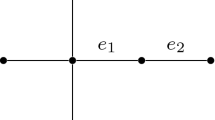Abstract.
The skewness of a graph is the minimum number of edges that have to be removed to leave a planar subgraph. This is complementary, and computationally equivalent, to the Maximum Planar Subgraph problem. In this paper we look at the problem of computing the skewness of a graph with a small cutset. We show how to express the skewness of a graph with a cutset of size at most 4 in terms of the skewnesses of several derived graphs obtained by cutting along that cutset and `stitching up' afterwards. We conclude with a discussion on possible applications to planarisation.
Similar content being viewed by others
Author information
Authors and Affiliations
Additional information
Received: May 15, 2001 Final version received: April 26, 2002
Acknowledgments. We thank Petra Mutzel for helpful comments on connections with her work, during a visit by the first author to the Institut für Informatik, Technische Universität Wien. We also thank John Crossley, Jonathan Hayes and a referee for their helpful comments. The work of §5 was completed while the first author was visiting the Department of Computer Science, Royal Holloway, University of London, Jan.–Feb. 2001.
Rights and permissions
About this article
Cite this article
Farr, G., Eades, P. Skewness of Graphs with Small Cutsets. Graphs and Combinatorics 19, 177–194 (2003). https://doi.org/10.1007/s00373-002-0501-0
Issue Date:
DOI: https://doi.org/10.1007/s00373-002-0501-0




